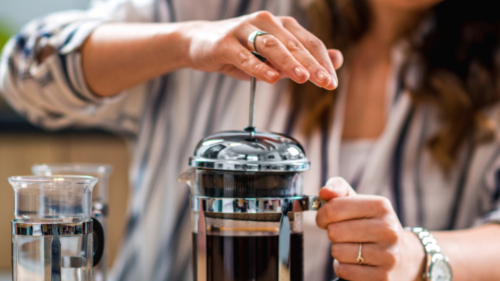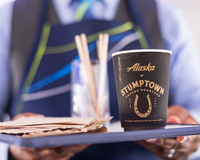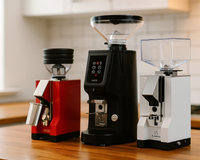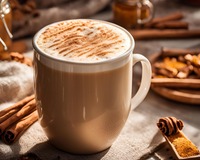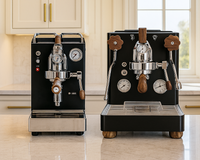Make Espresso With A French Press? I Don't Believe It!

In The Article: How to Make Espresso With a French Press
Yes! You can.
French press has become one of the most popular methods of brewing coffee in the United States. If you’re a coffee lover or addict, chances are you have one in your kitchen and even used it this morning. Espresso, while not the most popular brew method, is gaining momentum in the US. Most can be turned off by the amount of money you’ll find yourself spending on a top quality espresso machine. Believe it or not you don’t need an espresso machine to make espresso. There are actually a good amount of viable alternatives. Here are just a couple of those methods:
The last method that may surprise you is a French press! That’s right, you can make espresso with a French press. Here’s how:
Better Grinder=Better Coffee.
How To: Make Espresso With a French Press
1. Grind Your Beans
Remember – for espresso you’re looking for a very fine ground, as you don’t want water to be able to penetrate your coffee grounds very easily. French press brewing, on the other hand, requires a much coarser grind so be sure to adjust your grinder to a very fine grind setting.
Why grinding your beans directly before use is essential:
Maximized Freshness: Whole beans retain their flavors longer than preground coffee. Grinding immediately before brewing ensures the freshest possible flavor.
Enhanced Aroma: Freshly ground coffee releases volatile aromatic compounds that significantly enhance the aroma and taste.
Improved Flavor: Coffee begins to oxidize and lose its natural oils quickly after grinding, leading to a stale or flat taste. Grinding just before brewing preserves the full spectrum of flavors.
Customizable Grind Size: Grinding at home allows you to adjust the grind size to match your brewing method (e.g., coarse for French press, fine for espresso), ensuring optimal extraction.
Reduced Exposure to Moisture: Preground coffee is more susceptible to absorbing moisture from the air, which can degrade flavor and quality.
Better Control Over Consistency: A good grinder ensures uniform particle size, which promotes even extraction and reduces bitterness or sourness.
Longer Shelf Life for Beans: Whole beans have a longer shelf life compared to pre-ground coffee, allowing you to enjoy peak quality over time.
Connection to the Brewing Process: Grinding your beans creates a hands-on, engaging ritual that enhances the coffee-making experience.
Need a Grinder Recommendation?
The Baratza Encore is the perfect companion for coffee enthusiasts looking to elevate their brewing experience. Known for its reliability and ease of use, this entry-level burr grinder offers 40 grind settings, allowing you to achieve the ideal consistency for any brewing method—from French press to pour-over. Its precise burr design ensures uniform grinds, which is essential for optimal flavor extraction. With the Baratza Encore, you can enjoy freshly ground coffee every day, unlocking the full potential of your beans and transforming your morning cup into a café-quality experience.
2. Heat Your French Press With Warm Water
When making espresso with an espresso machine, it’s always advisable to have your Portafilter in the machine while it’s heating up. Temperature and thermal stability is essential to making quality espresso. With a French press, you’ll want to fill it up with warm water for a few minutes to pre-heat it. This is vital to creating warm, full-bodied espresso.
3. Heat Your Water
By using a teakettle, heat your water as if you were making tea. 195 degrees is about where you want your water to be.
4. Insert Your Coffee Grounds Into Your Pre-heated French Press
Amount – because the grind is much finer, you’re going to have to double the amount of coffee you’d usually put in for French press.
2 to 1 ratio (2 tablespoons of coffee for every 1 cup of water used).
Follow that formula and you’ll be golden –pun intended.
5. Add A Small Amount of Water
Normally at this point you’d fill your French press up half way to start brewing. With espresso, you’ll only want to add a touch of water to get your coffee “blooming.” During this process, coffee is releasing all it’s natural oils resulting in a more flavorful cup.
Should you just fill it up right away, you’ll still get espresso, it just wont taste as good as it could. Don’t rush the brewing process. It takes time but in the end, it’ll be well worth it!
6. Once The Coffee Is Blooming, Add The Rest Of Your Water
7. Stir
8. Add French Press Lid – DO NOT PRESS DOWN YET
Allow the coffee to brew and steep for a few minutes. If you’d like it to be stronger, give it more time and vice-versa. Placing the lid ensures heat doesn’t escape your French press during brewing. This, once again, is essential to creating quality espresso.
9. Press Down Slowly
Your Questions, Answered. FAQ
Can I really make espresso in a French press?
While a French press cannot produce true espresso due to its lack of pressure, you can create a strong, espresso-like coffee by using a finer grind and a higher coffee-to-water ratio. The result is rich and intense, great for lattes or other espresso-based drinks.
What grind size should I use?
For espresso-like coffee in a French press, use a fine to medium-fine grind. Avoid going too fine (like true espresso grind), as it can make pressing difficult and lead to sediment in your cup.
How much coffee should I use?
Use about 1:10 to 1:12 coffee-to-water ratio. For example, 30 grams of coffee for 300–350 grams (10–12 oz) of water. Adjust based on your strength preference.
How long should I let it steep?
Steep the coffee for 4–6 minutes, depending on your desired strength. A longer steep time extracts more flavors but can also introduce more bitterness.
What water temperature is best?
Use water just off the boil, around 195–205°F (90–96°C). Too hot water can over-extract and make the coffee bitter.
How do I press properly?
After steeping, gently press the plunger down evenly and slowly. Applying too much force can disturb the grounds and increase sediment.
Can I use pre-ground coffee?
While freshly ground coffee is always better, you can use preground coffee as long as it's a fine grind. However, the flavor and aroma won’t be as robust as with freshly ground beans.
Is it possible to froth milk for lattes or cappuccinos?
Yes! You can heat milk separately and froth it using a handheld frother or the French press itself. Just add warm milk and pump the plunger up and down vigorously until frothy.
What’s the difference in taste compared to espresso?
French press espresso-style coffee is less intense and lacks the crema of true espresso, but it’s still rich and bold, making it a great base for milk-based drinks.
Can I use dark roast beans?
Yes, dark roast beans work well for espresso-like coffee in a French press, delivering a bold, chocolatey, and smoky flavor profile.
Let's Sum It Up
Yes, you can absolutely make espresso in a french press.
It's best to grind your beans directly before brewing for optimal results and flavor.
Remember to pre-heat your french press with hot water prior to use.
There are alternatives. Moka Pot & Aeropress, for example.
Enjoy!


